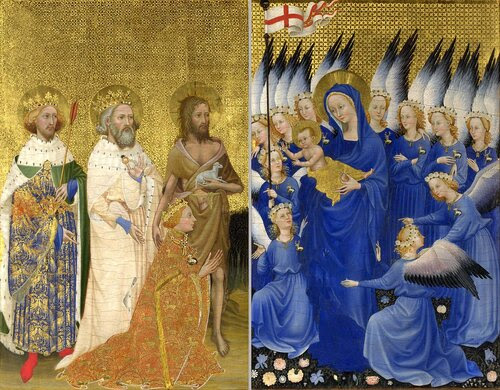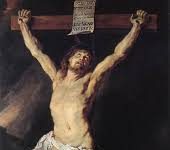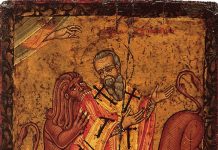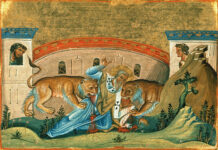(On this day, January 25th, in 1533, Henry VIII secretly married his paramour Anne Boleyn, for whom he had thrown off not only his true wife, Catherine of Aragon, but the papacy itself, to gain what he coveted. And so began the destruction of the Church in England. Anne would be beheaded on Henry’s order in 1536. By 1541, every monastery and shrine had been destroyed and dissolved. Henry died on January 28th, 1547, leaving England in ruins. What follows is a description from Rebecca Jacobson of this trajectory of the once-Catholic nation, with hope that what she once was, she may yet be again…)
The history of the Faith in England traces executioners and martyrs, sinners and saints, revolution and restoration. Throughout, the lives and works of men provide windows into the working out of God’s plan, and how individuals have the opportunity to bring an entire nation closer to, or farther away from, Christ. Five phases mark Church history in England: Conversion, Christendom, Revolution, Renewal, and the Modern Attack. The revolution against Catholicism deserves special attention, since its fruit has such far-reaching implications for Western Civilization. Henry VIII, Thomas More, Elizabeth and Campion are looming figures in this era. The subsequent renewal provides hope for the present day, in the Oxford Movement, figures such Newman and Chesterton, and the flowering of a new rite within the Church. Glimpses through the history of England show that God works through people and events—both good and evil—to bring hope and salvation to men and nations.
Seeds of faith in England were sown by the earliest Christian martyrs, before England was a nation. Accounts from Tertullian record Christians in Britain before the 3rd century, and, “during the Diocletian persecution British soil was reddened with the ever-fruitful seed of martyr-blood.”[1] Pope St. Gregory the Great, dubbed “Apostle of England,” sent St. Augustine to Kent at the end of the sixth century, where he encountered quite fertile soil for Christianity to grow.[2] The early Christians in Britain, well acquainted with suffering, had a strong warrior culture. In constant threat of invasion, they valued strength and courage, and had to reconcile this with a God who was ‘shamefully’ crucified. The Old English poem Dream of the Rood beautifully depicts Christ’s passion as a battle-victory: “Then the young hero made ready—that was God almighty—strong and resolute; he ascended on the high gallows.”[3] Hence, an understanding of courageous suffering for the Faith is rooted deep in British history.
Moving into the Medieval era, with the glories and challenges of Christendom, one seemingly small event is the apparition of Our Lady at Walsingham in 1061. It was called “the Nazareth of England,” because the shrine contained a replica of the house in which Mary was told she would be the mother of God.[4] Indeed, “the mystery of the Annunciation” is the particular emphasis of this apparition site.[5] Lady Richeldis de Faverches, a widow, “had prayed for a way in which she could honour the Blessed Virgin.”[6] Mary invited, “all who are in any way distressed or in need to seek [her] there,” at Walsingham.[7] It quickly became a popular pilgrimage site. St. Edward the Confessor, king at this time, “offered England to the virgin as her dowry.”[8] Subsequently, every English king, “from Henry II to Henry VIII,” made pilgrimages to this shrine.[9] Thus, through the devotion of one woman in a small corner of England, the hope-filled message of the Incarnation was brought anew to Europe, and Mary’s motherly presence revealed in a quiet way that would continue through the tumultuous centuries.
Next, consider the rupture from the Faith known as the Protestant Revolution. According to Belloc, England’s influence was an important factor that allowed the revolution to continue in the rest of the world: “Neither the Counter-Reformation nor the active fighting which succeeded in preserving a part of Christendom intact would have been necessary but for [the] difficult success of the Protestant movement in England.”[10] It began not as a matter of Church doctrine, but of marriage; yet, the rejection of the papacy “opened the door” for seizure of Church property, thereby “confirming the success of the Religious Revolution” by rapidly changing the economic scene.[11] Eventually, society began to exist in a divided manner, “a Protestant culture side by side with the Catholic culture”—unimaginable before the rift.[12] According to Belloc, it is necessary to understand the “English tragedy” to understand how the Protestant Revolution took hold so firmly everywhere else in the world, and hence, to understand the problems of modernity.[13]
Henry VIII, ascending the throne of England in 1509, shows how a seemingly good man can, through his vice, bring sorrow to a great many and change the course of history.[14] He seemed all set for a happy reign, possessing physical vigour and intellectual skills.[15] “His zeal for the doctrines of St. Thomas [Aquinas] and hatred of heresy added to his royal diadem the aureole of orthodoxy,” and he was even named Defender of the Faith by Pope Leo X. [16] It is thus no wonder that his subsequent actions took Catholics by surprise.
At its root, a dispute of doctrine was not the instigating factor behind the English divide from Rome; rather, it was Henry’s personal vice which started the division. Henry’s lust “made protestants of a king and nation who did not want to be Protestants at all, [causing] irreparable damage to so many souls.”[17] Greed followed after, as his dispute with the Pope created the opportunity to seize Church property. Cranmer and Cromwell were Henry’s right-hand men in this “rupture from Rome,” and made themselves and their ‘friends’ wealthy from the dissolution of the monasteries.[18] One tragic result was the destruction of the shrine at Walsingham. By “express order” of Henry VIII, the “defenders of the shrine” were executed, thus shedding their blood for the sake of the Church.[19] Henry’s infamous ‘Oath of Supremacy’ was enacted in 1534, requiring all his subjects in public or ecclesiastical office to swear allegiance to Henry as Supreme Head of the Church in England.[20] Pope Clement VII had denied Henry’s demand for an annulment of his first marriage with Catherine of Aragon; prompted by Cranmer and Cromwell, Henry thought that he could evade the Pope’s authority in this matter by declaring himself to possess both spiritual and temporal sovereignty in England. Ultimately, this oath forced faithful Catholics to prove with their necks their loyalty to the true Church in the question of authority.
Starkly contrasting Henry VIII’s moral weakness is the strength of St. Thomas More, who refused to take the Oath of Supremacy and paid for this with his head. More had held “the highest offices in the kingdom,” and was the “trusted friend and counsellor of Henry VIII.”[21] Yet, he did not place his trust in secular power, much less the good-will of his king. On this topic he remarked to his son-in-law, Roper: “Be assured the king will have my head cut off if this brings him in but one castle in France.”[22] Sure enough, he was “beheaded on July 7, 1535,” giving England one of her most well-known martyrs—effectively undoing Henry’s desire to ‘silence’ More’s influence.[23]
What was it that gave Thomas More his strong Faith, almost all alone? At the age of twenty two, More was all set up for an excellent career. He was “well-educated,” “intelligent, “wise beyond his years,” “likeable,” and well-connected in society.[24] He could have immediately started a successful political life. Instead, “before plunging into that maelstrom of power, wealth, and prestige, Thomas stopped, as if at the edge of a cliff, and spent the better part of four years forging an inner spiritual character that would mark him for the rest of his life.”[25] Thomas lived with the Carthusians, and there learned daily patterns of prayer and penance. This allowed him to create a deep interior life, “providing the anchor that would keep him on a steady course through very heavy seas.”[26] In short, Thomas cultivated virtues. He avoided wealth and fame, not allowing his heart to become attached to things that didn’t matter.[27] He created a joyful home life, rooted in prayer, showing that he could prioritize his vocation amidst the stressfulness of public life. “The depth of his interior life enabled him to keep reality firmly before his eyes in the midst of a world and a calling that was constantly tending to distraction and illusion.”[28] Having practiced this all his life, he was able to remain strong in the end. He refused to acknowledge earthly authority as Supreme Head of the Church in England, and for that, he joyfully — with humour, even — went to his death.[29]
Meanwhile, almost all the clergy in England acquiesced to the King. Of the bishops, only St. John Fisher remained true to Rome, also giving his head for it.[30] Sadly, “most of the cowardly bishops and priests proved unfaithful to their trust, took the subscribed oath… and preached against the tyranny of Rome.”[31] One can imagine the sorrow and confusion of faithful Catholics. Many clergy who conformed were simply, “waiting for the storm to pass.”[32] Cranmer, “Lutheran at heart” and more a political figure than a clergyman, was Henry’s pitiful aid in pushing for a break from Rome, calling the Pope the “anti-Christ.”[33] With great skill in prose he wrote the ‘Book of Common Prayer,’ which was “made obligatory on all” in 1552, the Mass being “abolished as idolatrous.”[34] Hence, the traditional rites of Catholics were thrown out and a new, earthly-instituted religion enforced on Englishmen by pain of death.
Skipping ahead a few years brings one to the reign of Elizabeth, with continued persecutions. Catholics took a little breath in the years between, hoping for a recovery of Catholic culture; however, that last hope ended with Elizabeth’s new Act of Supremacy in 1559, and renewed persecution of adherents to the old Faith.[35] People had learned from Henry VIII, and this time, the bishops were more firm in their opposition: “Of the sixteen Catholic bishops, all except one steadfastly refused to submit.”[36]
Catholicism was made illegal under Elizabeth, and the possession of any sacramental, even a rosary, was looked upon as treasonous; to be found as a Catholic priest in England was a sure death sentence. Jesuits from the University at Douai, France, took up the missionary challenge and heroically ministered to the beleaguered English flock. Most well-known among these is the indomitable St. Edmund Campion. He served the English Catholics in secret, constantly fleeing the authorities while giving hope to English Catholics — an uncomfortable and heroic life indeed. When he was finally caught, he suffered brutally on the rack and was executed 1581.[37] In the same year, Campion wrote a work called his Ten Reasons, addressed to the “learned men of the universities of Oxford and Cambridge.”[38] It was penned in response to their dislike of his “Brag,” a letter he wrote to affirm his adherence to the Faith. He challenges them to fair debate, but the only answer they give, he says, is to “fill the air with their cries: ‘Your conspiracy! your seditious proceedings! your arrogance! traitor! aye marry, traitor!’ ”[39] Thus, he says he must resort to a written defence. He begs them to give the religious question the serious attention that their “own salvation” demands, encouraging boldness in pursuit of the true faith:
Only give yourselves up to take interest in this inquiry, entreat Christ, add efforts of your own, and certainly you will perceive how the case lies, how our adversaries are in despair, and ourselves so solidly founded that we cannot but desire this conflict with serene and high courage.[40]
Campion’s confidence is that of one who knows that final victory is in God, stating the paradox which has confused and strengthened people ever since the crucifixion of Christ: “I may be killed, beaten I cannot be.”[41]
Catholicism was afterwards buried in England, its culture becoming that of staunch Protestantism. Newman, a later convert, describes first-hand the minimal Catholic presence in 19th century England:
Perhaps, as we went to and fro [in London], looking with a boy’s curious eyes through the great city, we might come today upon some Moravian chapel, or Quaker’s meeting-house, and tomorrow on a chapel of the ‘Roman Catholics;’ but nothing was to be gathered from it, except that there were lights burning there, and some boys in white, swinging censers; and what it all meant could only be learned from books, from Protestant Histories and Sermons; and they did not report well of the ‘Roman Catholics.’” [42]
Belloc describes a suppression of rational thought as part of the dangerous fruit of the break from Rome, manifested in an over-dependence on one’s “good fortune.”[43] He states that, “there was no commoner phrase on the lips of Protestant Englishmen than the phrase, “we are not a logical nation” for each man was his own religion, “each protestant group was ‘God’s country.’ ”[44] Yet it was not possible that every different religious group could be God’s ‘favoured ones,’ who would come out on top. Belloc argues that this sense of superiority is dangerous, opening “the door to every extravagance, material and spiritual; to conceptions of universal dominion, world power, and the rest of it.”[45] Hence, the Protestant ideology which overtook English culture opened the door for later evils in society. But, for now, back to hopeful things, and the renewal of the Faith in England.
Campion’s challenge to the men of Oxford was answered—perhaps belatedly—by the intellectual wrestling of discontent Anglicans in the 19th century, dubbed the ‘Oxford Movement.’ This was the beginning of the Catholic revival in England, the fruit of ideas and discussions within an initially small group of Oxford professors. These men sought a return to the traditional Faith within the Anglican beliefs and liturgy. The Oxford men set forth their doctrinal arguments in tracts, and thus were called Tractarians, perhaps an unintended similarity to Campion and his tracts.[46]
Newman became a strong leader in this movement, his dynamism, eloquence, and sincerity unintentionally gaining him many followers and eventually leading him home to the Catholic Faith. His epitaph reads: Ex umbris et imaginibus in veritatem (out of shadows and symbols unto truth), a testament both to his quest for truth and his classical formation.[47] Raised with a “modified Calvinism,” as a young person he had a deep interior life.[48] He became disappointed in his Christian views as he grew older, wandering through various notions of Christianity before becoming an Anglican minister. He believed that the Anglican church was the via media between Protestantism and Rome.[49] As the Oxford Movement picked up speed, Newman worked tirelessly, his energy stirring many into thought and action. In fact, Newman “wrote so much that his hand almost failed him.”[50] Controversy blew up when he wrote Tract 90, which was just too Catholic for the established church: “before it blew over, Newman had entered the Catholic Church” in 1845.[51]
Cardinal Ratzinger remarked that for Newman, pursuit of truth is inseparable from the concept of conscience. Newman “emphasized truth’s priority over consensus, over the accommodation of groups.”[52] Newman is oft-quoted in this regard, stating that a man’s conscience is “the voice of God,” and “the aboriginal Vicar of Christ.”[53] Ratzinger also notes Newman’s poem, Lead Kindly Light, which describes a humble surrender to God’s plan over his own: “I loved to choose and see my path but now, lead thou me on.”[54] Newman’s conversion was the first of many in England. Hence, Newman answers the call of Campion to pursue truth with reasoned debate, and his work overthrew that of King Henry, and even Cranmer, “in the end.”[55]
The Oxford Movement marked the first wave of Catholic renewal, followed by one in the literary sphere. Chesterton is a notable figure in this era, and his publication of Heretics (1905) and Orthodoxy (1908) marked the revival of Christian thought in mainstream literary society, an “artistic and intellectual response to the prevailing agnosticism of the age.”[56] G. K. Chesterton, Maurice Baring and Hilaire Belloc were some of the most well-known writers, influential both for their skill in argumentation and their engaging literary style. These men “shared not only a common friendship, but a common philosophy and a common faith,” and together formed a strong community.[57] A great many notable authors sprang up in this time, including J.R.R. Tolkien, C. S. Lewis, R. H. Benson, and Edith Sitwell, to name a few.[58] The friendships among these authors strengthened and energized their work.[59] A common theme was the pursuit of Truth, Beauty and Goodness, finally found in the Catholic Faith.
The restoration of the shrine at Walsingham is also a sign of the renewal in England. Mary’s house was re-constructed in 1829, “when Catholics were allowed to practice their faith again,” and to this day there is an Anglican shrine at the apparition site.[60] Mary is thus a point of healing between Rome and the separated Christians, and is the patron of a new rite that sprung up through the renewal of Catholicism in England.
Moving now into the joys and issues of Catholicism in modern England, the institution of the Personal Ordinariate shows how God brought good even from the rupture that occurred under Henry VIII. In November of 2009, Pope Benedict XVI issued the apostolic constitution, Anglicanorum Coetibus. This allowed for the creation of a new rite, bringing the Anglicans into communion with Rome while maintaining certain elements of their liturgy.[61] Interestingly, this includes Cranmer’s ‘Book of Common Prayer,’ which, paradoxically, has now become a pivotal part of the renewal of Catholicism in England (and around the world). God brings beauty out of the ashes!
The Faith in modern England faces new challenges, such as apathy among its faithful, increasing death of innocents through abortion and similar ‘medical treatments,’[62] and great difficulty accessing the sacraments.[63] Amidst these and other very real struggles, glimmers of hope shine forth, such as the re-dedication of England to Mary as her dowry in February 2020.[64] Mary, who through a faithful widow and saintly king in Medieval England created a physical place for the joy of the Incarnation to be encountered, brought this place through the tumultuous 16th century and into the modern era. She remains an ever-present help for her children.
Belloc summarizes the current situation well, calling the modern crisis “a wholesale assault upon the fundamentals of the Faith.”[65] The movements of the modern day can be judged by their fruits, among which are materialism and slavery to the State.[66] Like in Campion’s day, this new crisis is also an attack on reason, as “the ancient process of conviction by argument and proof is replaced by reiterated affirmations.”[67] Yet faith cannot be divorced from reason, from man’s “use of intelligence.”[68] Hence, Belloc predicted that either the Church will recede into a small, insignificant and persecuted group, “Or we shall be able to lift at the end of the struggle the old battle cry, “Christus Imperat!”[69] This is the deciding hour, the final battle over “the very existence of the Faith.”[70]
Church history depicts many times in which she has looked beaten, but was not. It is exemplified in the blood of the martyrs and in the very scandal of Christ Crucified.[71] Upon this paradox the Faith is founded. Individuals throughout history, such as Thomas More, Campion, Newman and Belloc, point to the way in which the faithfulness of individuals play a part in the continued restoration of the Faith in every era. Christ sent his Mother to intercede for the English people, so that even the works of unfaithful men, such as Cranmer, are turned to good — as is seen in the new flowering of faith in England. Thus, the history of England provides glimpses into God’s working out of salvation history, often though courageous suffering, starting within the hearts of men.
Cited
Barry, W. “Biographical Essay” on Newman, John Henry, in Catholic Encyclopedia (1911), accessed Nov. 22, 2021, https://newmanreader.org/biography/biography.html.
Belloc, H. Characters of the Reformation: Historical portraits of 23 Men and Women in the Great Religious Revolution of the 16th Century (Illinois, USA, TAN Books and Publishers Inc.: 1992).
Belloc, H. The Great Heresies (USA, TAN Books: 1991).
Pope Benedict XIV, Anglicanorum coetibus, Apostolic Constitution, 4 November 2009.
Campion, E. Ten Reasons, Preface, accessed Nov. 22, 2021, https://sensusfidelium.us/apologetics/ten-reasons-st-edmund-campion/preface/.
Joseph Black, Leonard Conolly, Kate Flint, Isobel Grundy, Don LePan, Roy Liuzza, Jerome J. McGann, Anne Lake Prescott, Barry V. Qualls, Claire Waters, The Broadview Anthology of British Literature: Volume 1, The Medieval Period, 3rd ed. (Canada, Broadview Press, 2020).
Laux, Fr. John. Church History: a history of the Catholic Church to 1940 (North Carolina, USA: 1989).
Newman, J.H. Letter to the Duke of Norfolk, in “Newman Reader ch. 5: Conscience,” accessed Nov. 22, 2021, https://www.newmanreader.org/works/anglicans/volume2/gladstone/section5.html.
Pearce, J. Literary Converts: Spiritual Inspiration in an Age of Unbelief, (San Francisco: Ignatius Press, 1999) XI.
Ratzinger, quoted in, “Thoughts of Cardinal Ratzinger (Pope Benedict XVI) about John Henry Newman,” accessed Nov. 22, 2021, http://www.newmanfriendsinternational.org/en/thoughts-of-cardinal-ratzinger-pope-benedict-xvi-about-john-henry-newman/.
Varghese, R. A. God-Sent: A History of the Accredited Apparitions of Mary (USA, The Crossroad Publishing Company: 2015).
Williams, Jerome K. True Reformers: Saints of the Catholic Reformation (Augustine Institute, 2017).
Catholic News Agency, https://www.catholicnewsagency.com/news/248000/record-number-of-abortions-recorded-in-england-and-wales-in-2020, accessed Nov. 22, 2021.
The Catholic Church Bishop’s Conference of England and Wales, https://www.cbcew.org.uk/opening-catholic-churches-for-private-individual-prayer-a-big-step-forward-for-society/, accessed Nov. 22, 2021.
Cardinal Vincent Nichols, Diocese of Westminster, https://rcdow.org.uk/cardinal/homilies/pastoral-letter-for-the-sixth-sunday-in-ordinary-time/ accessed Nov. 22, 2021.
[1] Laux, Fr. John. Church History: a history of the Catholic Church to 1940 (North Carolina, USA: 1989) pg. 195.
[2] Laux. Church History. pg. 197.
[3]The Dream of the Rood in The Broadview Anthology of British Literature: Volume 1, The Medieval Period, ed. Black, Joseph et. al., 3rd ed. (Canada, Broadview Press, 2020) pg. 50, line 39.
[4] Varghese, R. A. God-Sent: A History of the Accredited Apparitions of Mary (USA, The Crossroad Publishing Company: 2015) pg. 72.
[5] Varghese. God-Sent, 73.
[6] Varghese. God-Sent, 72.
[7] Varghese. God-Sent, 73.
[8] Varghese. God-Sent, 72.
[10] Belloc. H. Characters of the Reformation: Historical portraits of 23 Men and Women in the Great Religious Revolution of the 16th Century (Illinois, USA, TAN Books and Publishers Inc.: 1992) pg. 5.
[11] Belloc, Characters, 4.
[12] Belloc, H. The Great Heresies (USA, TAN Books: 1991) 123.
[13] Belloc. Characters, 8.
[14] Laux. Church History, pg. 446.
[15] Laux. Church History, pg. 446.
[16] Laux. Church History, pg. 446.
[17] Laux. Church History, pg. 446.
[18] Laux. Church History, pg. 447.
[19] Varghese. God-Sent, 72.
[20] Laux. Church History, 448.
[21] Laux. Church History, 448.
[22] Laux. Church History, 448.
[23] Laux, Church History, 449.
[24] Williams, Jerome K. True Reformers: Saints of the Catholic Reformation (Augustine Institute, 2017) pg. 37.
[25] Williams. True Reformers, 38.
[26] Williams. True Reformers, 39.
[27] Williams. True Reformers, 42.
[28] Williams. True Reformers, 40.
[29] Williams. True Reformers, 52; a note on More’s humour: When More was ascending the platform to be beheaded, he was quite weak. “I pray you, Mr. Lieutenant,” he said, “see me safe up. For my coming down, let me shift for my self” (Williams. True Reformers, 57).
[30] Laux. Church History, 448.
[31] Laux. Church History, 448.
[32] Laux. Church History, 445.
[33] Laux. Church History, 447 and 448.
[34] Laux. Church History, 450.
[35] Laux. Church history, 452.
[36] Laux. Church History, 452.
[37] Laux. Church History, 453.
[38] Campion, E. Ten Reasons, Preface, accessed Nov. 22, 2021, https://sensusfidelium.us/apologetics/ten-reasons-st-edmund-campion/preface/
[39] Campion, Ten Reasons.
[40] Campion, Ten Reasons.
[41] Campion, Ten Reasons.
[42] Laux. Church History, 537.
[43] Belloc. Heresies, 140.
[44] Belloc. Heresies, 140.
[45] Belloc. Heresies, 141.
[46] Laux. Church History, 135.
[47] Laux. Church History, 536.
[48] Barry, W. “Biographical Essay” on Newman, John Henry, in Catholic Encyclopedia (1911), accessed Nov. 22, 2021, https://newmanreader.org/biography/biography.html.
[49] Barry. “Biographical Essay.”
[50]Barry. “Biographical Essay.”
[51] Laux. Church History, 536.
[52] Ratzinger, quoted in, “Thoughts of Cardinal Ratzinger (Pope Benedict XVI) about John Henry Newman,” accessed Nov. 22, 2021, http://www.newmanfriendsinternational.org/en/thoughts-of-cardinal-ratzinger-pope-benedict-xvi-about-john-henry-newman/.
[53] Newman, J.H. Letter to the Duke of Norfolk, in “Newman Reader ch. 5: Conscience,” accessed Nov. 22, 2021, https://www.newmanreader.org/works/anglicans/volume2/gladstone/section5.html.
[54] Ratzinger, “Thoughts.”
[55] Barry. “Biographical Essay.”
[56] Pearce, J. Literary Converts: Spiritual Inspiration in an Age of Unbelief, (San Francisco: Ignatius Press, 1999) XI.
[57] Pearce. Literary Converts, 9.
[58] Pearce. Literary Converts, XI.
[59] Pearce. Literary Converts, XI.
[60] Varghese. God-Sent, 73.
[61] “This single Church of Christ, which we profess in the Creed as one, holy, catholic and apostolic “subsists in the Catholic Church, which is governed by the successor of Peter and by the Bishops in communion with him. Nevertheless, many elements of sanctification and of truth are found outside her visible confines. Since these are gifts properly belonging to the Church of Christ, they are forces impelling towards Catholic unity.” Pope Benedict XIV, Anglicanorum coetibus, Apostolic Constitution, 4 November 2009.
[62]https://www.catholicnewsagency.com/news/248000/record-number-of-abortions-recorded-in-england-and-wales-in-2020, accessed Nov. 22, 2021.
[63]https://www.cbcew.org.uk/opening-catholic-churches-for-private-individual-prayer-a-big-step-forward-for-society/, accessed Nov. 22, 2021.
[64]Nichols, Cardinal V. https://rcdow.org.uk/cardinal/homilies/pastoral-letter-for-the-sixth-sunday-in-ordinary-time/ accessed Nov. 22, 2021.
[65] Belloc. Heresies, 143.
[66] Belloc. Heresies, 149.
[67] Belloc, Heresies, 154.
[68] Belloc. Heresies, 154.
[69] Belloc. Heresies, 155.
[70] Belloc. Heresies, 134.
[71] 1 Corinthians 1:22-25











